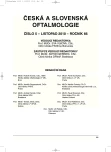Visual Evoked Potentials in Management of Amblyopia in Children
Authors:
M. Gromová; A. Gerinec
Authors‘ workplace:
Klinika detskej oftalmológie LF UK DFNsP, Bratislava, prednosta prof. MUDr. Anton Gerinec, CSc.
Published in:
Čes. a slov. Oftal., 66, 2010, No. 5, p. 223-228
Category:
Original Article
Overview
Goal:
The authors want to point out the possibility of using the visual evoked potentials (VEP) in the diagnostic process of amblyopia, especially in preverbal children. We also researched the possibility of screening for amblyopia with VEP in young patients with anisometropia without strabismus being present, especially those who come from affected families. The authors followed changes in the course of an occlusion therapy and suggest that VEP could be used to predict a success of the amblyopia therapy.
Material and methods:
We analyzed group of 45 pediatric patients ages 2–10 years who were investigated in years 2006–2009 at Pediatric Ophthalmology Department of Children University Hospital in Bratislava with amblyopia. This group was compared with a control group of 25 healthy children. The cause of amblyopia in a majority of children (29 patients) was hyperopic anisometropia, 13 children had hyperopic isometropia, 3 patients had myopia over -3D. These causes in 22 children were combined with strabismus. The monocular pattern of VEP was evaluated in all patients. In cooperative children (25) we also evaluated binocular pattern of VEP. 18 patients with amblyopia had a second VEP evaluation done during the occlusion therapy, among those were 23 amblyopic eyes. The time frame from the first VEP evaluation to the second VEP evaluation was 1–11 months, average 5,1 months. The material was statistically evaluated.
Results:
Our study showed statistically significant prolongation of the latency of both P and N2 waves (p = 0.01) in children with amblyopia. This can be used in diagnostic process of amblyopia in preverbal children as well as in the screening for amblyopia. We also followed changes during the occlusion therapy and we discovered persistent prolongation of the latency of the P wave and also changes in the amplitudes (p = 0.05) During repeated measurements and with applied therapy one can follow the dynamics of amblyopia, course of therapy by VEP changes.
Conclusions:
Results of our research suggest a great contribution of VEP especially in the diagnosis of anisometropic amblyopia, especially in preverbal children. The advantage of VEP is in the screening, prediction and dynamics of therapy too. The amblyopia management is a long lasting process requiring a thorough communication and cooperation among the patient, parent and a doctor.
Key words:
visual evoked potentials, VEP, amblyopia, occlusion therapy
Sources
1. Asper, L., Crewther, D., Crewther, SG.: Strabismic amblyopia, psychopsysics. Clin. Exp. Optom., 83, 2000, 2 : 49–58.
2. Barrett, B., Bradley, A., McGraw, P.: Understanding the neural basis of amblyopia. Neuroscientist, 10, 2004, (2): 106–116.
3. Campos, EC.: Amblyopia. Surv. Ophthalmol., 40, 1995, (1): 23–39.
4. Cobb, CJ., Russell, K., Cox, A, MacEwen, CJ: Factors influencing visual outcome in anisometropic amblyopes. Br. J. Ophthalmol., 86, 2002, (11): 1278–1281.
5. FitzGerald, DE., Krumholtz, I.: Maintenance of improvement gains in refractive amblyopia: A comparison of treatment modalities. Optometry, 83, 2002, (3): 153–159.
6. Gerinec, A.: Detská oftalmológia, Martin, Osveta, 2005, 592 s.
7. Chen, PL., Chen, JT., Tai, MC. et al.: Anisometropic amblyopia treated with spectacle correction alone: possible factors predicting success and time to start patching. Am. J. Ophthalmol., 143, 2007 : 54–60.
8. Iliakis, E., Moschos, M., Hontos, N., Tsalouki, JK., Chimonidou, E.: The prognostic value of visual evoked response latency in the treatment of amblyopia caused by strabismus. Doc. Ophthalmol., 92, 1996-97, (3): 223–228.
9. Lawwill. T.: Electrophysiologic aspects of amblyopia. Ophthalmology, 85, 1978, 451-463.
10. Ohlsson, J., Baumann, M., Sjostrand, J., Abrahamsson, M.: Long term visual outcome in amblyopia treatment. Br. J. Ophthalmol., 86, 2002, (10): 1148–1151.
11. Ohn, YH., Katsumi, O., Matsui, Y., Tetsuka, H., Hirose, T.: Snellen visual acuity versus pattern reversal visual-evoked response acuity in clinical applications. Ophthalmic. Res., 26, 1994, (4): 240–252.
12. Thompson, D: Developmental Amblyopia. In: Principles and Practice of Clinical Electrophysiology of Vision. 2006. MIT Press, Massachusetts, 977 p.
Labels
OphthalmologyArticle was published in
Czech and Slovak Ophthalmology

2010 Issue 5
Most read in this issue
- Indication Avastin in Ophthalmology
- Subjective Visual Perception after Laser Treatment of Myopia on two Types of Lasers
- Selective Laser Trabeculoplasty in Glaucoma Treatment – Results during three Years Follow-up
- Visual Evoked Potentials in Management of Amblyopia in Children
